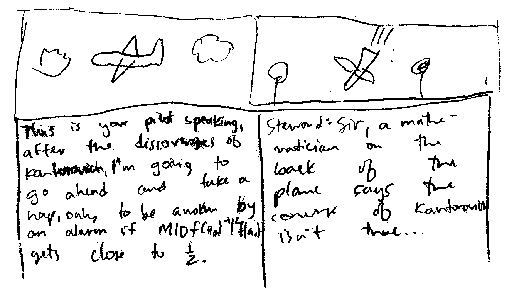These are notes I hope may be useful. Please let me know if you find any errors.
Slides from conference lecture in Roscoff, France.This is an advanced course for beginning math majors; the topics are introductory linear algebra, multivariable calculus, and manifold theory. The textbook is by John Hubbard, and the instructor for the course at the time I made these notes was Todd Kemp. (I was the teaching assistant.)
Complex numbers
pdf dvi
Open sets, closed sets, and continuity
pdf dvi
Euler's identity and derivatives
pdf dvi
Limits of rational functions
pdf dvi
Geometry of systems of linear equations
pdf dvi
Fundamental Theorem of Linear Algebra, and graphing
pdf dvi
Abstract vector spaces (class lecture)
pdf dvi
Newton's method
pdf dvi
Inverse Function Theorem
pdf dvi
Manifolds
pdf dvi
Proof of Taylor's Theorem for real-valued Ck-functions
of several variables
pdf dvi
Taylor's theorem with tensors
pdf dvi
Gaussian curvature of surfaces
pdf dvi
Created by math 223 student Alex Gates for his paper on the spectral theorem,
using my
directory photo.
Written by math 223 student Kevin Poenisch, on the occasion of the final.

Captions:
“This is your pilot speaking. After the discoveries of Kantorovich, I’m going
to go ahead and take a nap, only to be awoken by an alarm if
M | Df (a0)-1 |2 f (a0)
gets close to 1/2.”
Steward: “Sir, a mathematician on the back of the plane says the converse of
Kantorovich isn’t true…”
Kantorovich’s Theorem gives conditions that guarantee convergence of Newton’s
method to a root of a given C1 function f.
(The plane analogy is that the plane’s height is the function value;
for the plane, “converging to a root” means crashing to the ground.)
It states that, if the above expression has a value less than or equal to 1/2,
then the function has a unique root in a certain ball (determined by the first
step of Newton’s method), and that Newton’s method will converge to it.
(M is a Lipschitz constant for the derivative, ensuring that it
doesn’t change too quickly.)
back to my main page
back to my directory page at the Cornell math department